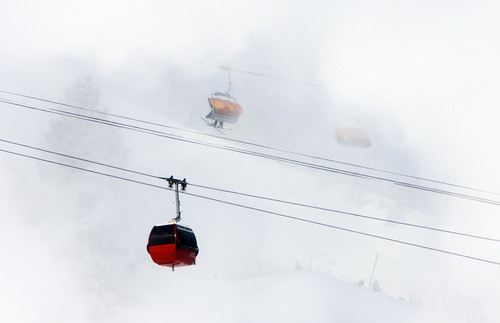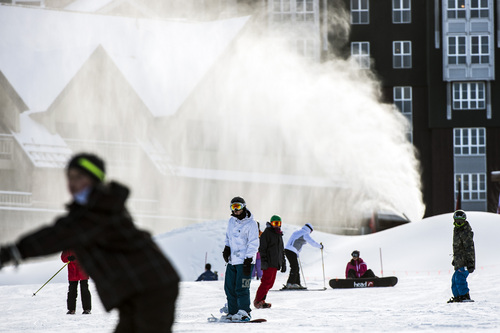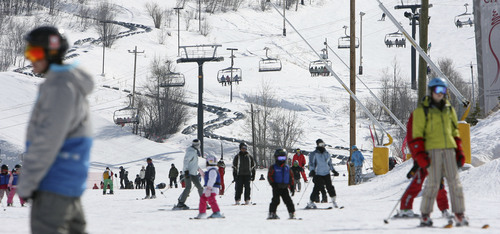This is an archived article that was published on sltrib.com in 2013, and information in the article may be outdated. It is provided only for personal research purposes and may not be reprinted.
Few doubt that Vail Resorts' presence in Utah will elevate the state's ski industry to a new level, bringing more money and respect to the wondrous Wasatch Mountains.
But the industry giant's arrival also has been unusually fractious among Utah's historically harmonious collection of 14 independently owned resorts, each with its own niche.
No sooner was Vail introduced May 29 as the new operator of Canyons Resort than it took a lead role in litigation that theoretically could shut down neighboring Park City Mountain Resort (PCMR).
That sent jitters through Park City. The whole Utah ski community took note, knowing there are broader ripple effects from what happens in that three-resort hub — Deer Valley being the third — for the destination skier crowd.
And while Vail has said it has no plans to act on an eviction notice delivered Aug. 28 to PCMR, there is still great uncertainty about what will emerge from the lawsuit.
Will there be two independently owned resorts? Or will Canyons and PCMR end up as one giant resort controlled by Vail and Talisker Corp., which owns Canyons and most of the mountainside PCMR leased for the past 50 years — a lease PCMR allegedly failed to renew on time.
John Cumming, chief executive of PCMR's parent company, PowdrCorp., denies that such a lapse occurred. He pleaded his case in the court of public opinion two weeks ago with a guest editorial in the Park Record newspaper, telling Vail and Talisker "their efforts to take over PCMR are futile and not in the best interests of the community."
Blaise Carrig, who oversees Vail's operations in Utah as president of the company's mountain division, rejected any caricature of Vail as a big bully coming into Park City and pushing the locals around.
"We recognize there's anxiety about [the lawsuit]. We've tried to calm that as best we can," said Carrig, who was president of Canyons Resort from 1997 to 2002 when now-defunct American Skiing Co. owned it.
"We have no desire to close [PCMR] operations and harm the community. But we have to go through the lawsuit. There are legal issues that need to be taken care of," he said. "Hopefully, the outcome will be a win for everybody."
The lawsuit has pushed SkiLink into the background.
"That's dormant right now," Carrig said of Canyons Resort's controversial proposal to build a gondola to Solitude Mountain Resort in Big Cottonwood Canyon. "From the very beginning, we put SkiLink on the back seat. … That's not a priority for us."
While those words may comfort the environmental and backcountry skiing communities, Save Our Canyons' Executive Director Carl Fisher remains wary of the pressure Vail could exert to embolden a Utah ski industry he already views as expansionist.
"Vail has the financial backing to pursue many things that have been just talked about," Fisher said. "There's a potential to see more action and less talk about knocking down the doorsteps of the Wasatch backcountry."
There's plenty of talk now:
• A major environmental impact study on transportation in the central Wasatch, encompassing the seven resorts in Salt Lake and Summit counties, is in its infancy.
• Salt Lake County is updating its rules regulating development in the canyons and foothills. The main recommendation: Create a zone specifically for resorts.
• The U.S. Forest Service is evaluating its approach to summer recreation at resorts that use public lands — including Alta, Snowbird, Brighton and Solitude.
To Fisher, Vail's presence makes it imperative that "we really ramp up our efforts to make sure we not only get a vision enacted in master plans and forest plans, but also that they're upheld strongly and confidently. We need to bolster these ordinances because they will be challenged."
—
Welcome to the majors • One indisputable point is that Vail brings a major-league name to Utah, one known all over the world. And to Vail, Utah fits snugly into its long-range plans.
"We always felt Utah was a missing piece of our portfolio," Carrig said. "Utah has great mountains, a great reputation for skiing, great access and, certainly, the [2002] Olympic legacy has helped the profile of Utah nationally and internationally," he said.
Vail preceded its move into Utah with several acquisitions likely to attract more visitors to Park City.
Already well-positioned in Colorado with four resorts (Vail, Beaver Creek, Breckenridge and Keystone), the company beefed up its Lake Tahoe holdings by buying Northstar in 2010 and Kirkwood in 2012.
Last December, it purchased two "urban" ski areas, Afton Alps outside of Minneapolis and Brighton Mountain near Detroit, not so much for the revenue the resorts generate but for market access. Neither city has been targeted specifically before by Utah ski advertising.
"A large number of people in Minnesota and Michigan take Western vacations," Carrig said. "That's the connection we were looking for. We're selling Epic Passes in those markets."
Because Salt Lake City International Airport is just an hour from Canyons, that could be big for Utah. It's an easy hop from Los Angeles and San Diego. Minneapolis and Detroit also have direct flights to Salt Lake.
"We hope Utah is attractive in helping us get more penetration in the Southern California market," Carrig said.
Bob Wilbanks, editor of The National Ski Club Newsletter, predicted Utah will see a big visitation increase because of the Epic Pass.
"All of that market they've developed on the West Coast and Colorado is available," he said, "and you've got ski clubs all over the country who now have a reason to come to Utah."
The pass's popularity has compelled Utah's other resorts — perhaps fearful of losing business to Canyons — to team up on deals. Alta and Snowbird are part of the Mountain Collective and have a package with Deer Valley and PCMR. Solitude and Brighton have a joint pass.
"Competition has made people respond," Carrig said. "That's good for the consumer."
—
Changes ahead • Utah ski historian Mike Korologos agrees, observing that "maybe local ski areas will be a little more benevolent with their locals' outreach."
In general, Korologos is bullish on Vail's move into Utah, as are many in the state's ski establishment. "Vail's just pushed us into the big leagues," he said, likening its arrival to the University of Utah's entry into the PAC 12.
"The mighty Utes always wanted to play with 'the big boys' and now they are — and having growing pains," Korologos added, just as Utah resorts need to adjust their future business models to a new reality with Vail in town. "Times are bigger now."
Alan Engen, a historian with a lifetime attachment to Alta, said he has "nothing but the highest regard for Vail's operations in Colorado." His main concern is that "things don't get so big and commercialized that it degrades the whole picture."
Once the boss of PCMR, Phil Jones said he doesn't see a downside to Vail being here and expects visitors will spend a few days at other Utah resorts.
"Vail is corporate. Some people may not think that's a positive," Jones said. "But it provides opportunities that will ripple through the industry, the whole community."
Added Jim Gaddis, a collegiate skiing champion in the early 1960s and later a coach: "Vail does everything well. It will do a really good job of improving Canyons, which is already good but needs to do some subtle things with runs and snowmaking. Vail is more than capable and knowledgeable about doing those things."
Perhaps no one is watching the evolving situation more than Bill Malone, executive director of the Park City Chamber Bureau.
While the litigation concerned him at first, Malone has come to think that "after everything settled down and people figured out it's a lawsuit between two big corporations … it didn't really have an impact on what we do or whether people select [Park City] as their destination."
Vail's marketing will be more influential in driving those decisions, he added. "There's a whole audience out there that may have been wanting to go to Utah — and now they have a good reason." —
Vail's expansion
Signing a long-term contract in May to run Canyons Resort for its owner, Talisker Corp., was the latest in a series of moves Vail Resorts Inc. made in recent years to expand its influence over the world of U.S. skiing.
• Vail bought Northstar resort on Lake Tahoe's northern shore for $60.2 million on Oct. 25, 2010.
• The company enhanced its marketing reach by buying Skiinfo, a Norwegian company that owns and operates several ski websites in Europe, for $5.7 million on Feb. 1, 2012.
• Vail added Kirkwood Mountain Resort southwest of Lake Tahoe to its portfolio for $18.2 million on April 12, 2012.
• The company bought Afton Alps Resort in Minnesota and Mount Brighton in Michigan for $20 million in December 2012 to attract more Midwestern customers.
• Talisker Corp. signed Vail to a 50-year contract (with six 50-year extensions) to manage Canyons Resort outside of Park City, starting at $25 million a year. —
Join us Monday for Trib Talk
On Monday at 12:15 p.m., Jennifer Napier-Pearce talks with Nathan Rafferty, of Ski Utah; Carl Fisher, of Save Our Canyons, and Salt Lake Tribune reporter Mike Gorrell about how Vail's entry into Utah fundamentally changes the state's ski scene.You can join the discussion by sending questions and comments to the hashtag #TribTalk on Twitter and Google+.













